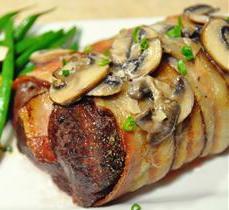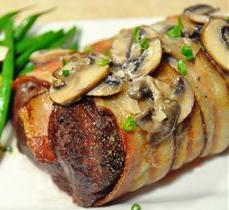Venison Tenderloin Bacon with Garlic Cream Sauce
Venison Tenderloin Bacon with Garlic Cream Sauce
A new way to create a wonderful venison dish.
Ready in: 1 hour 30 minutes
Serves: 6
Complexity: easy
kcal: 310
Share

Ingredients
6 thick slices bacon
2 (450 g) venison tenderloin roasts
2 tsp rice bran oil, divided
1 tsp SIDS SMOKEY BBQ RUB
¼ tsp onion powder, divided
SIDS SALT & PEPPER to taste
2 tbsp butter
250 g button mushrooms, sliced
2 cloves garlic, chopped
1 tbsp chopped spring onion, to taste
½ cup heavy whipping cream, to taste
Directions
Preheat oven to 190°C.
Place bacon on a slotted baking pan and bake in the oven until partially cooked but still flexible, 6-8 minutes.
Brush venison tenderloins with oil and season with SIDS SMOKEY BBQ RUB, onion powder and SIDS SALT & PEPPER. Place tenderloin roasts side by side and wrap them together in strips of partially cooked bacon. Place into a roasting pan.
Roast until bacon is browned and an instant-read meat thermometer inserted into the thickest part of a tenderloin reads at least 65°C, about 1 hour.
Heat butter in a saucepan over medium heat then cook and stir mushrooms and garlic in hot butter until mushrooms are soft, 8-10 minutes. Pour in cream and cook, stirring often, until sauce is heated through. Serve sauce with tenderloins.
Cook's Note:
Every butcher is different in cuts of venison. Some will cut tenderloins into steaks like filet mignon. Others will leave like small roasts. (which we believe keeps the meat tender and won't dry out) Every deer will produce different sizes of tenderloin as well, so you must adjust recipe accordingly.
History: Venison derives from the Latin venari (to hunt or pursue). This term entered English through the Norman in the 11th century, following the Norman invasion of England, and the establishment of Royal Forests. Venison originally described meat of any game animal killed by hunting and was applied to any animal from the families 'Cervidae' (deer), 'Leporidae' (hares) and 'Suidae' (wild pigs) and certain species of the genus Capra (goats and ibex), but in the northern hemisphere the word's usage is now almost entirely restricted to the flesh of various species of deer.

